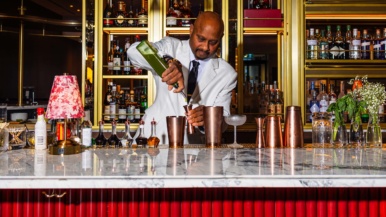What’s on the menu at Osteria Rialto, the Paradise Theatre’s new Italian restaurant

Name: Osteria Rialto
Contact: 1006 Bloor St. W., 416-306-8123, osteriarialto.com, @osteriarialto
Neighbourhood: Bloorcourt
Owner: Moray Tawse (Paradise Theatre, Tawse Winery)
Executive chef: Executive chef Basilio Pesce (Porzia, La Banane, Biff’s), chef de cuisine Ryan Baddeley (Bar Isabel, Bar Raval) and executive pastry chef Jill Barber (Blackbird Baking Co.)
Accessibility: Fully accessible
The food
Pesce’s current menu draws influence from—but is not limited to—Ligurian, Tuscan and Roman cuisines. Pesce says there’s no real regional focus as the team wants to highlight different dishes from all over the boot. “I find it really hard to do traditional Italian dishes, because you just don’t have the same ingredients or items,” says Pesce. “And if you start shipping in everything from Italy, you kind of lose that regional, everything-is-grown-here concept.” Instead, the menu features a tagliarini with Fogo Island snow crab, a dry-aged bistecca alla Fiorentina and fresh pasta made in-house and by Famiglia Baldassarre. And Barber’s desserts, while French in technique, are made with seasonal ingredients and Italian winter citrus fruits, like bergamot and kumquat.








The drinks
“I thought it would be fun to imagine a cocktail menu of French classics that have Italian twists,” says Goodfellow. “So it’s like something from the region of Chambéry.” For example, a Brandy Alexander made instead with white vermouth and gin is reborn as the Alexandra. The Italian-dominated wine list was curated by Stephanie Morra (Paris Paris, Midfield Wine Bar, Terroni), and features unblended varietals indigenous to each pocket of Italy. The selection is divided into two parts: the Vino da Tavola for sparkling, rose, whites and reds, and the Vino de la Cantina, which features selections from the restaurant’s cellar and reserve list.





The space
Located on the ground floor of the 1937 heritage building, the restaurant’s narrow space is decked out in a mix of warm wood and exposed brick, with brass and Art Deco accents. A private dining cellar can hold parties of up to 12 guests, and a soon-to-come all-season patio will double the restaurant’s capacity.















